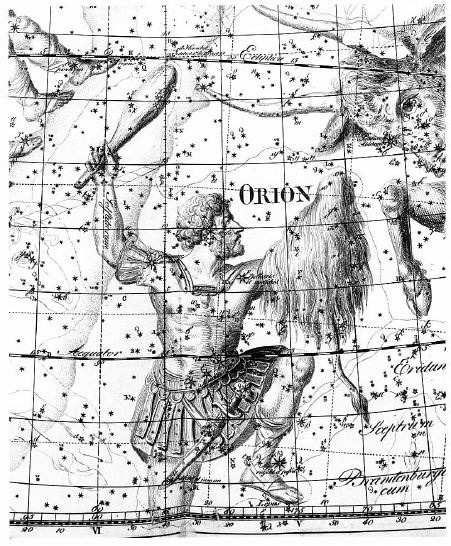The USNA, Einstein, and Betelgeuse (and did I mention Gunsmoke?!?!)On December 13, 1920, Albert Abra
The USNA, Einstein, and Betelgeuse (and did I mention Gunsmoke?!?!)On December 13, 1920, Albert Abraham Michaelson and Francis Pease measured the diameter of the star Betelgeuse, the first measurement of the size of any star other than the Sun. Although the relative size of Betelgeuse has been in dispute since then mostly due to its massive size and incredible speed through space, the methods devised by Michaelson and Pease have been used for decades. The name Betelgeuse is derived from the Arabic يد الجوزاء (Yad al-Jauzā’), meaning the Hand of al-Jauzā, al-Jauzā being the constellation known in the west as Orion the Hunter. Betelgeuse is the right shoulder (or armpit) of Orion and the alpha star of the constellation. The letter B in Betelgeuse, however, was a mistransliteration from Arabic into medieval Latin of the first character Y, which was misread as a B. Betelgeuse arrived in English in 1515 as a direct phonetic transliteration of the Arabic as Ibt al Jauzah, which due to this misspelling was also mistranslated as the Armpit of the Central One. Intermediary forms include Bed Elgueze, Beit Algueze, Betelgeux and Betelgeuze, finally settling on Betelgeuse around the time Michaelson and Pease were measuring the star.Everything about this star has been misunderstood for centuries, starting with its name in English and continuing to the present day. When Michaelson and Pease attempted to measure its size, interferometry was still a new science and early estimates both missed its size and proximity. Long considered the largest star in the catalog (currently Betelgeuse ranks third largest), Betelgeuse is a massive red super giant millions of times larger than the sun. As recently as the last ten or fifteen years the size and distance of Betelgeuse have been refined and updated as new and improved methods have been implemented. Michaelson, the scientist who first measured Betelgeuse, had a life scripted by Hollywood: his parents fled Poland when he was only two years old and settled in the American West. Michaelson received an appointment from no less than President Ulysses S. Grant to attend the fledgling United States Naval Academy in Annapolis, Maryland where he began his scientific endeavors in earnest. He is actually more famous for his experiments to measure the speed of light accurately, known as the Michaelson-Morley experiment, which he began while in Annapolis in 1887 and which he continued to refine for decades as he tried to measure the impact of aether on the speed of light. He never was able to find evidence of aether, often anglicized as ether, which later became significant and celebrated when Einstein published his Special Theory of Relativity. The word ether entered English in the 14th century via Old French from the 12th century directly from the Latin aether, itself a transliteration of the Ancient Greek aither (αἰθήρ) meaning in both languages pure air, the upper (bright) sky, the firmament. He was awarded most major scientific prizes including the Nobel Prize of 1907 and is considered the first American to win that prize. His life was so dramatic and crammed with achievement that his early life and appointment to USNA managed to penetrate into popular culture when his life was celebrated on an episode of Gunsmoke, in which an unpleasant local teacher attempts to block his advancement. The episode Look to the Stars was broadcast in March 1962, 31 years after his death on May 9, 1931. Although Michaelson and Pease’s first measurement has been in flux since publication, this was not due to flaws in their science or methodology. As recently as 1991 the Yale University Observatory measured the distance to Betelgeuse at 330 light years. The Hipparcos Input Catalog measured the distance two years later at 650 light years, almost doubling Yale’s measurement. In 2008 a team working with Very Large Array Radio Telescopes lead by Graham Harper measured the distance at 643 light years with a margin of error of plus or minus 146 (!!!) light years. -- source link
Tumblr Blog : kidsneedscience.tumblr.com
#michaelson#einstein#betelgeuse#astronomy#history#science#etymology

